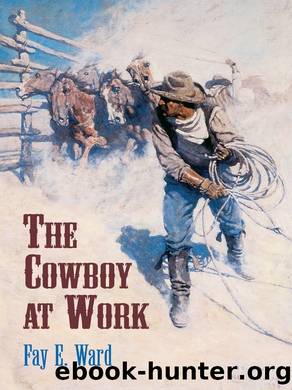The Cowboy at Work by Fay E. Ward

Author:Fay E. Ward [Ward, Fay E.]
Language: eng
Format: epub
Tags: History, United States, General
ISBN: 9780486146232
Google: n0rCAgAAQBAJ
Publisher: Courier Corporation
Published: 2013-02-13T01:09:13+00:00
16
HACKAMORES
Three types of riding hackamores (probably from the Spanish, jáquima, âheadstallâ) are shown on Plates 35 and 36. The old style of hackamore shown in Figure 1 on Plate 35 is the one most generally used for all-around purposes. It is used as a halter, and also, by attaching a pair of reins to the noseband underneath the horseâs jaw, as a riding headstall to handle broncs with.
The various parts of the hackamore are designated by the letters A, B and C in Figure 1 on Plate 35. A indicates the headstall, consisting of a brow band and the cheek pieces; it is generally made of either saddle strings or latigo leather, which is a pliable oil-tanned leather. C is the feador, often called âtheodore,â which is generally made of a good grade of medium-weight sash cord about five-sixteenths of an inch in diameter. Small strands of hair or hemp rope are also used when the sash cord is not procurable. B designates the noseband which is generally made of plaited rawhide.
Rope nosebands of three different designs are shown in the center at the top of Plate 35. Figure 2 is practically the same as the noseband shown on the hackamore just described. Figure 3 is a type of noseband designed for riding purposes only. The two large smothering knots are intended to help cut off the flow of air through the horseâs nostrils. This type of noseband did not become popular because those who tried it out found that it did more harm than good since the cutting of a horseâs wind makes him fight his headâand when that happens he is apt to do anything to get rid of the rider. It only served to make the bronc mad and that always causes trouble.
Figure 4 is a double-strand noseband made with one continuous piece of rope, as shown by the two loop ends. The double strands make a wider noseband than the single strand. The single-strand is more popular than the double-strand, due, perhaps, to the lower cost and because of the construction of the end, which, being solid, is more substantial.
The bosalea (from the Spanish bozal, âmuzzleâ) shown in Figure 5 on Plate 35, is strictly a riding headstall for breaking broncs and is not intended to be used in tying a horse up to an object, as can be done with the hackamore or a hackalea (Figure 7). A flat metal nose piece forming the front part of the noseband is indicated by the double arrow between Figures 5 and 6. Figure 6 shows how the noseband is constructed. The two Bâs indicate the rings to which the reins are attached. They give added leverage on the horseâs head when he is being turned. The metal nose piece, which is about five-eighths of an inch wide and one-eighth of an inch thick, is secured to rings on the side of the noseband, which is adjustable. The bosalea is constructed so as to cause the horseâs nose to become sore or tender from the pressure brought to bear on it by the pull of the reins.
Download
This site does not store any files on its server. We only index and link to content provided by other sites. Please contact the content providers to delete copyright contents if any and email us, we'll remove relevant links or contents immediately.
| Africa | Americas |
| Arctic & Antarctica | Asia |
| Australia & Oceania | Europe |
| Middle East | Russia |
| United States | World |
| Ancient Civilizations | Military |
| Historical Study & Educational Resources |
Machine Learning at Scale with H2O by Gregory Keys | David Whiting(4183)
Never by Ken Follett(3793)
Fairy Tale by Stephen King(3220)
The Man Who Died Twice by Richard Osman(2997)
Oathbringer (The Stormlight Archive, Book 3) by Brandon Sanderson(2885)
Will by Will Smith(2793)
Rationality by Steven Pinker(2291)
The Dark Hours by Michael Connelly(2245)
Can't Hurt Me: Master Your Mind and Defy the Odds - Clean Edition by David Goggins(2228)
The Dawn of Everything: A New History of Humanity by David Graeber & David Wengrow(2122)
Friends, Lovers, and the Big Terrible Thing by Matthew Perry(2119)
Principles for Dealing With the Changing World Order: Why Nations Succeed and Fail by Ray Dalio(1974)
HBR's 10 Must Reads 2022 by Harvard Business Review(1777)
A Short History of War by Jeremy Black(1762)
Go Tell the Bees That I Am Gone by Diana Gabaldon(1687)
515945210 by Unknown(1599)
A Game of Thrones (The Illustrated Edition) by George R. R. Martin(1589)
Kingdom of Ash by Maas Sarah J(1527)
443319537 by Unknown(1470)
